Cephalanthus occidentalis
You gotta love a plant that makes you do a double-take. One that really makes you pull your shades down for a second, unobstructed eyeful. Take the buttonbush, for example.
At first glance, your gaze may pass over a buttonbush’s rounded habit and lush green leaves. Don’t get me wrong, they’re certainly pretty. But those features aren’t exactly rare in a deciduous shrub.

We link to vendors to help you find relevant products. If you buy from one of our links, we may earn a commission.
What’ll quickly draw your eyes back to the plant, though, are its unique blooms: spheres of white, fragrant flowers, out of which protrude long, skinny floral styles.
When taking it all in, the flower reminds many folks of a pincushion. Personally, I see it as more of a ping-pong ball that’s gotten its money’s worth from an acupuncturist.
Regardless of what you think the blooms resemble, they’re uniquely spherical and interesting enough for you to really lose yourself in their beauty.
And after the flowers later give way to colorful, ball-like fruits, you’re in for an aesthetic treat all over again.
Ready to grow these shrubs for yourself? Then strap yourself in for this growing guide.
Here’s what we’ll cover:
What You’ll Learn
What Is Buttonbush?
Buttonbushes – aka honey bells, button willows, and globe flowers – are woody deciduous shrubs from the Rubiaceae family, alongside relatives such as energy-boosting Coffea plants and malaria-treating species of Cinchona.
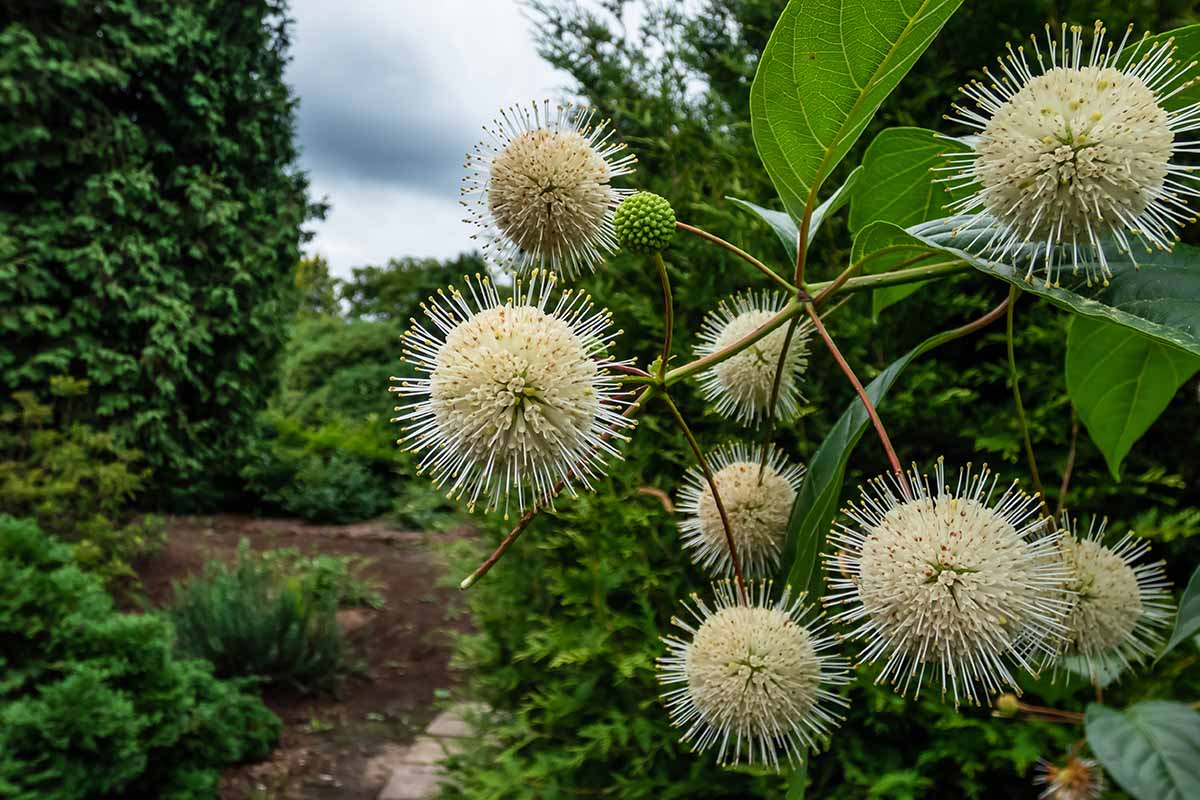
Hardy in USDA Zones 4 to 11, Cephalanthus occidentalis is widely distributed across its native continent of North America, spanning an area ranging as far north and east as Nova Scotia, as far west as California’s Central Valley, and as far south as Mexico.
Prone to growing wild in wet and/or lowland spots, buttonbushes typically reach mature heights and spreads of three to 15 feet.
With a rounded and open growing habit, C. occidentalis spreads via suckering, and often requires some pruning to avoid a lanky or disheveled look. With some well-executed limbing up, a buttonbush can even have the look of a small tree.
Buttonbush is one of the later US native shrubs to leaf out, with oval to elliptical green leaves that appear in late spring.
Autumnal colors can be insignificant, either yellow or mottled brown. When the leaves drop, the gray, furrowing-with-age bark becomes more apparent.
In summer, the aforementioned flowers appear, with their globe-shaped, white, and scented inflorescences bearing needle-like styles.
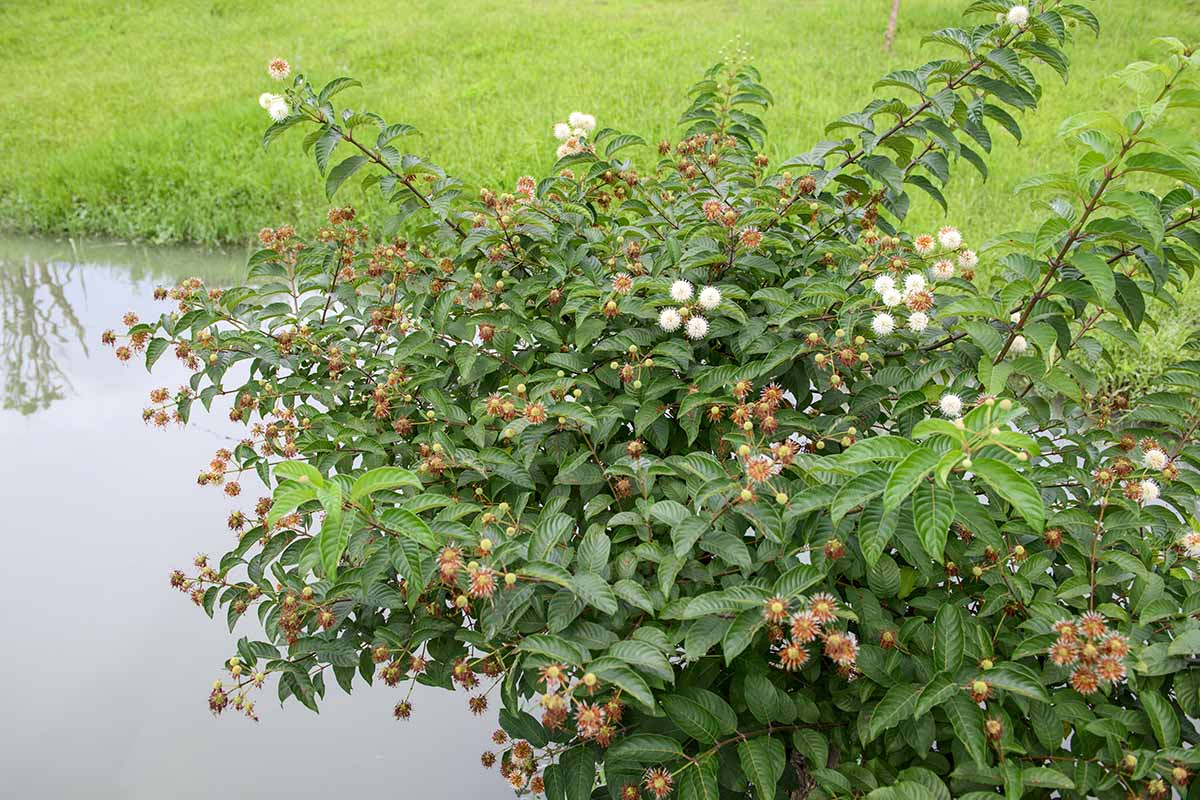
These flowers are arranged in circular clusters on the ends of stems, which the genus name Cepalanthus – from the Greek kephale and anthos, respectively meaning “head” and “flower” – roughly alludes to.
After fertilization via avian and/or insect pollinators, the flowers give way to hard, globular, yellow to red fruits in late summer. Throughout the fall, they mature and darken to brown. These often persist throughout the winter, taking on black hues.
Collectively, the leaves, flowers, and fruits of buttonbushes are super attractive to a wide variety of critters.
Dozens of bird species love the plant, from hummingbirds to songbirds to waterfowl. Insects such as bees, butterflies, and moths are drawn to the plant as well.
Cultivation and History
C. occidentalis is not just visually appealing – it’s also quite useful.
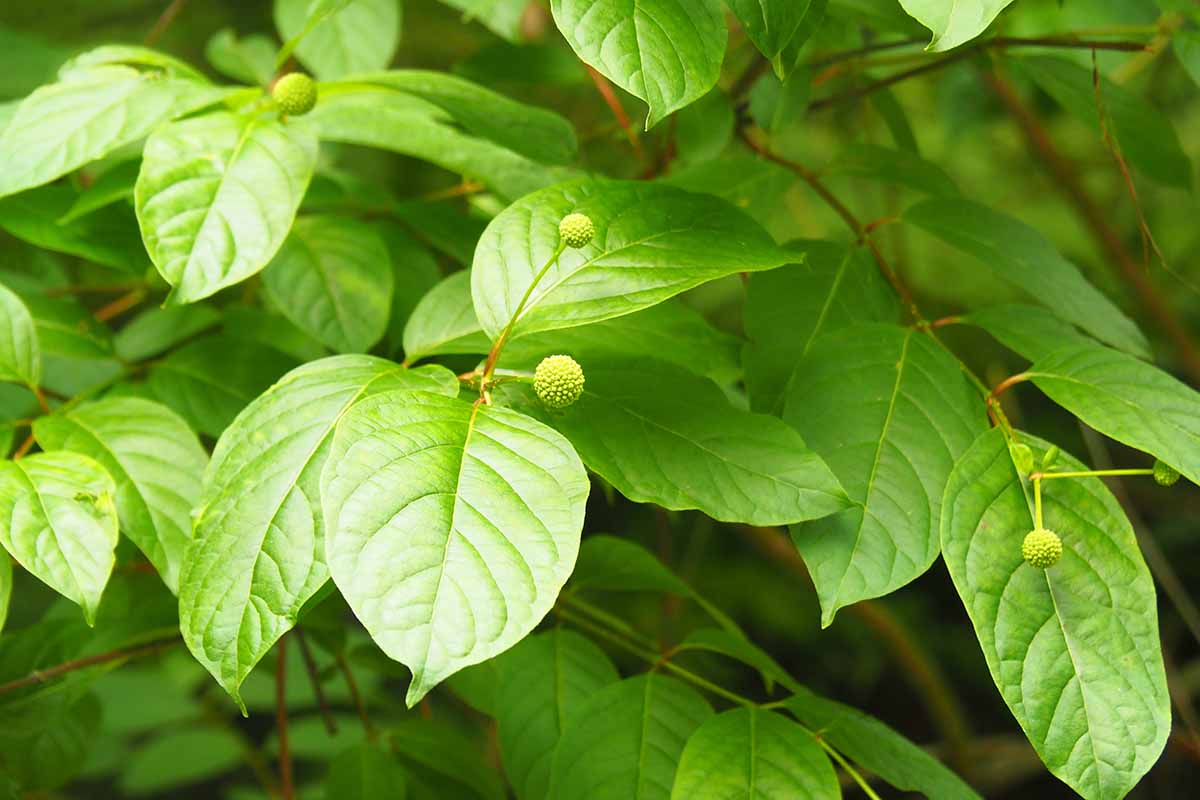
Medicinally, various groups of Native Americans have found many applications for buttonbush.
They used the bark and/or the roots to treat diarrhea, inflammation, rheumatism, headaches, fevers, toothaches, and venereal disease.
A Note of Caution:
C. occidentalis contains poisonous cephalathin, which can induce vomiting, convulsions, and paralysis when ingested.
Any medicinal experimentation with buttonbush should be done at your own risk and under the guidance of a professional.
The root systems and growth tendencies of buttonbushes make these shrubs helpful for controlling erosion and stabilizing riparian zones, i.e. land that’s right alongside bodies of water.
As a major attractor of wildlife, C. occidentalis is an important plant in its natural ecosystem, a position that conservationists aim to preserve.
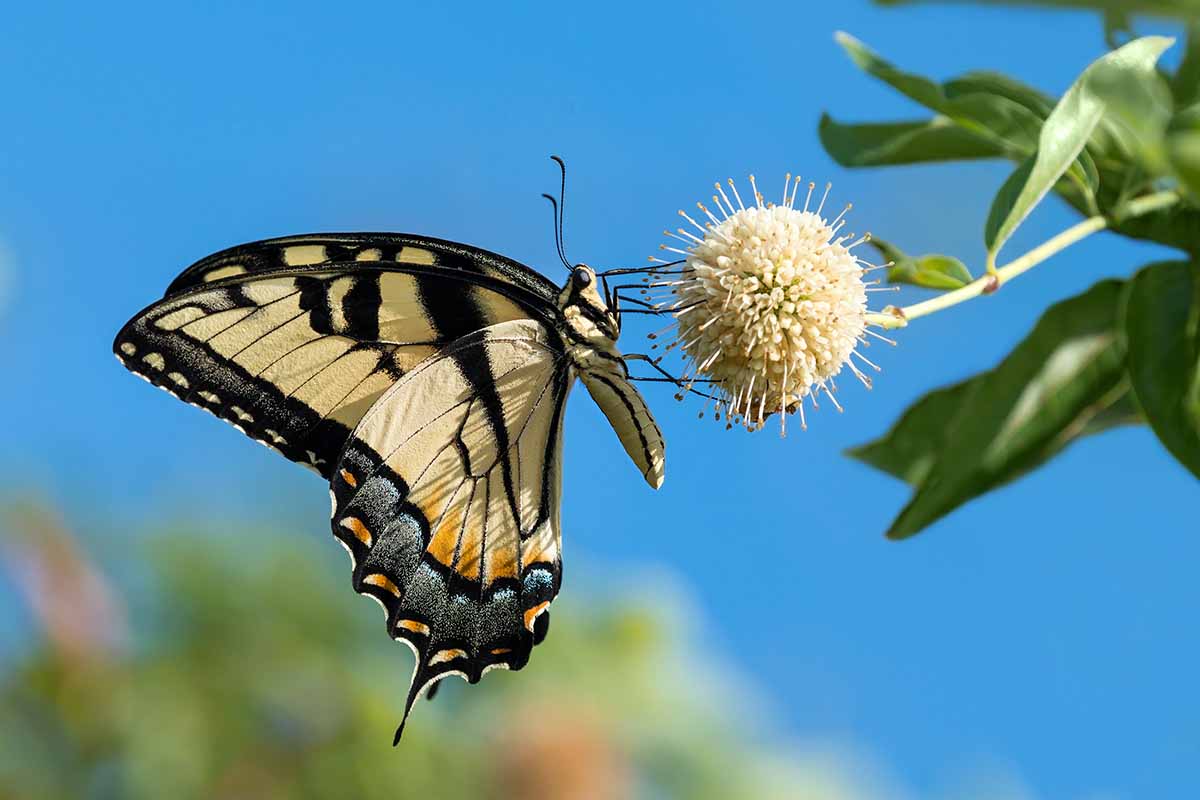
But let’s not forget a buttonbush’s aesthetics. While maybe not as formal in appearance as a well-trimmed boxwood shrub, C. occidentalis is super interesting and inviting to look at, which makes it well worth adding to the landscape.
Buttonbush Propagation
Trying to propagate some buttonbush? The best ways of doing so are by sowing seeds, rooting cuttings, or simply transplanting.
From Seed
Remember those fruits from earlier? Upon closer examination, you’ll find that they’re actually composed of numerous arrowhead-shaped seeds.
Once the fruits are a ripe reddish-brown in fall, break apart the fruits to reveal the individual seeds.
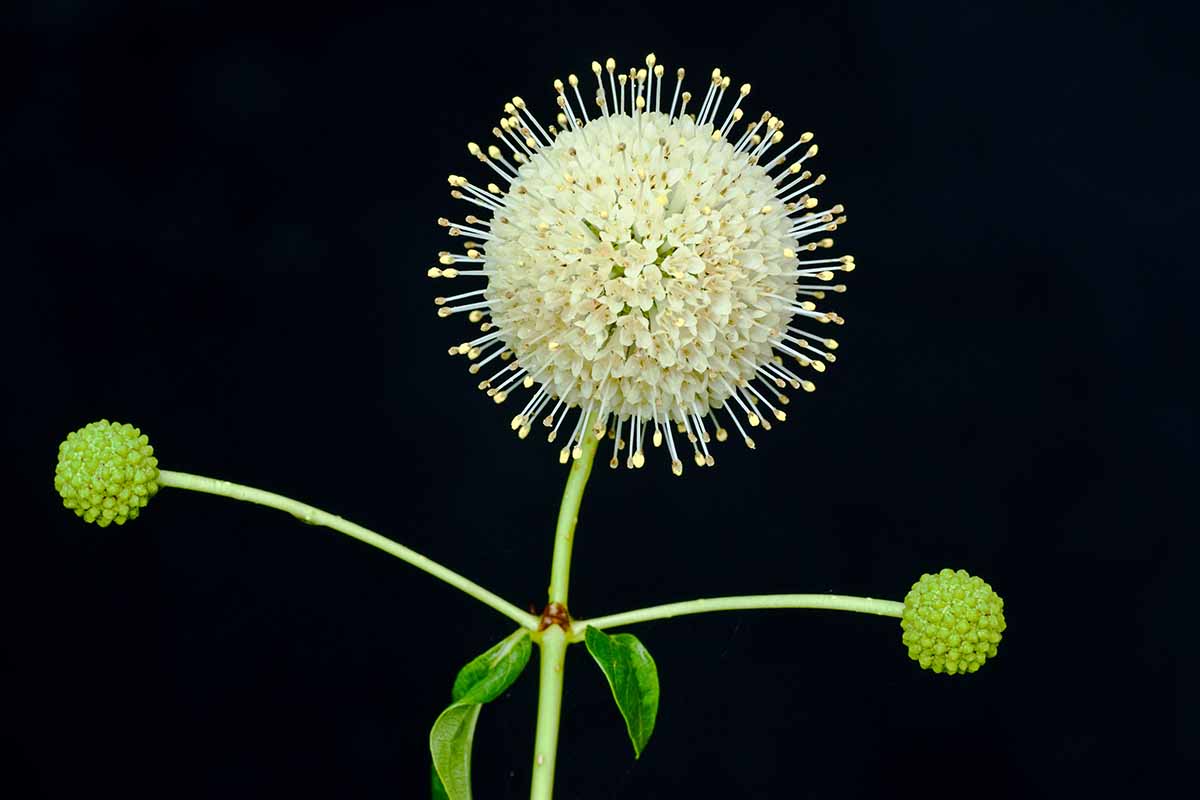
Once you’ve got some seeds – either collected or purchased – they’re ready for sowing in fall, prior to the arrival of frost. Thankfully, they don’t require any scarification or stratification.
From here, you can either sow them directly in-ground, or sow them into outdoor containers.
If you can’t provide protection from harsh winter conditions or competing plants in their intended permanent location, then it’s best to go with propagating in containers until the seedlings are ready to transplant.
In-ground seeds should be spaced two to four feet apart and planted just below the surface in moist, fertile soil before the arrival of first frost in colder zones.
Container-bound seeds should each occupy a three-inch container filled with a 50:50 mix of peat moss and perlite, also sown just beneath the surface. Ensure that the seedlings will receive full sun to partial shade.
Moisten the soil around the seeds, and be sure to maintain that moisture as the seedlings grow and develop.
For containerized seeds in cold conditions, move them in and out of shelter as needed, whether it’s into a cold frame, greenhouse, or otherwise more protected part of the garden.
Repot container-grown seedlings if they begin to outgrow their containers, in pots about two inches larger than their root systems.
After about a year of growth, containerized seedlings are ready for transplanting into their forever homes.
From Cuttings
Want a perfect genetic clone of your OG buttonbush? Then propagating cuttings is the way to go.
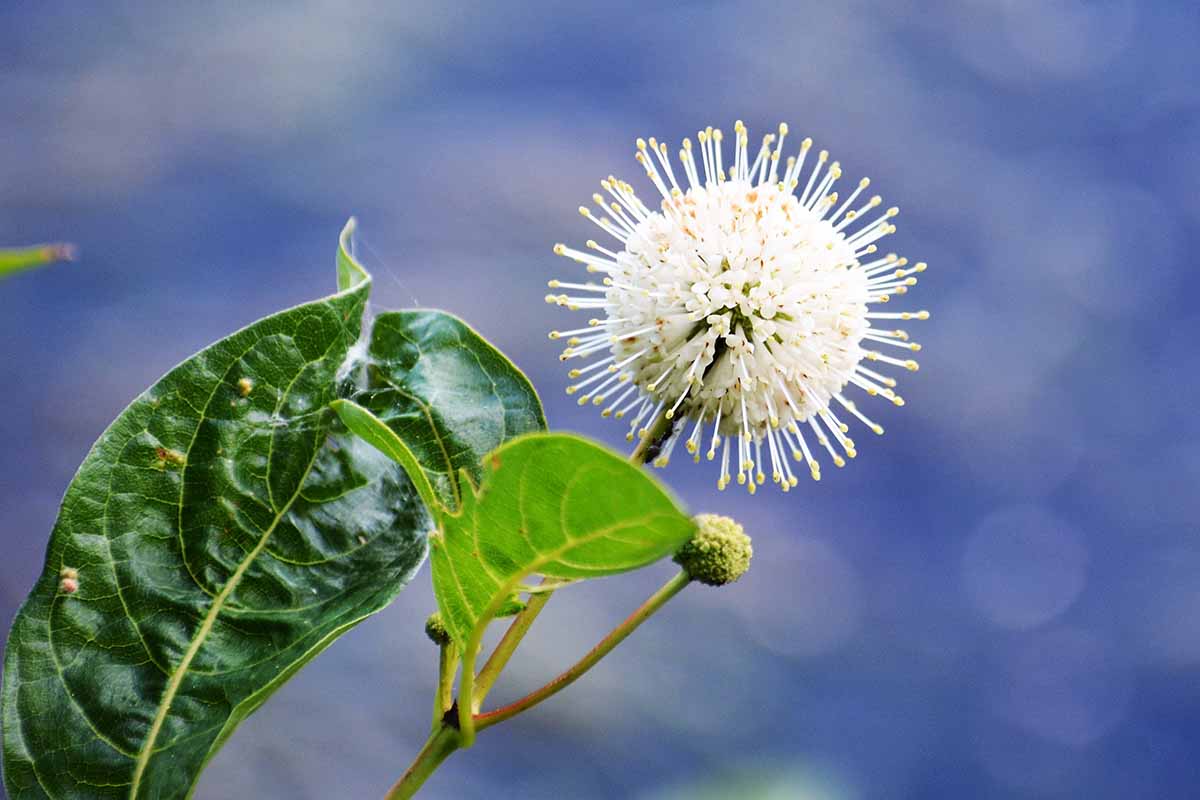
In summer, use a sterilized blade to take softwood cuttings four to six inches in length from the ends of young branches.
Defoliate the bottom half of each, and dip the cut ends into a rooting hormone, like this IBA powder from Bonide that’s available from Arbico Organics.
Bonide Bontone II Rooting Powder
Stick the dipped end of each cutting into its own three-inch container filled with a 50:50 mix of peat moss and sand, then water it in.
Place the containers somewhere indoors where they will receive bright, indirect sunlight, such as a windowsill. Rooting should occur in a month’s time.
Repot as needed, making sure to keep the media moist all the while.
The following spring or summer, harden off the rooted cuttings by leaving them outside in full sun to partial shade for 30 to 60 minutes before bringing them back indoors.
Add an additional half to full hour of outdoor exposure each day until the plants can spend a full day outdoors.
At this point, they’re ready for transplanting!
From Seedlings/Transplanting
Prior to transplanting, prepare planting sites in fertile garden soil with a pH of 6.0 to 8.0, situated in full sun to partial shade.

Space these sites at least two feet apart. For some on-the-house moisture, select sites adjacent to a body of water such as a pond or stream.
For small varieties or juvenile specimens that you wish to grow in containers, you can prepare appropriately-sized pots, filling each with a 50:50 mix of peat moss and perlite.
Dig a hole that’s about as deep and a bit wider than each transplant’s root system. Take the transplants and carefully lower them into their prepared holes.
Take the dug-out soil, mix in some humus such as compost or well-rotted manure, and begin to backfill the holes. Alternate backfilling with watering until the holes are filled and watered in. Now you’re done, kudos!
How to Grow Buttonbush Shrubs
To end up with those fabulous flowers and fruits, optimal cultivation is essential. Let’s dive into what “optimal” means for a buttonbush.
Climate and Exposure Needs
For a C. occidentalis to thrive, it needs to be grown in USDA Hardiness Zones 4 to 11. A pretty wide range, if you ask me.
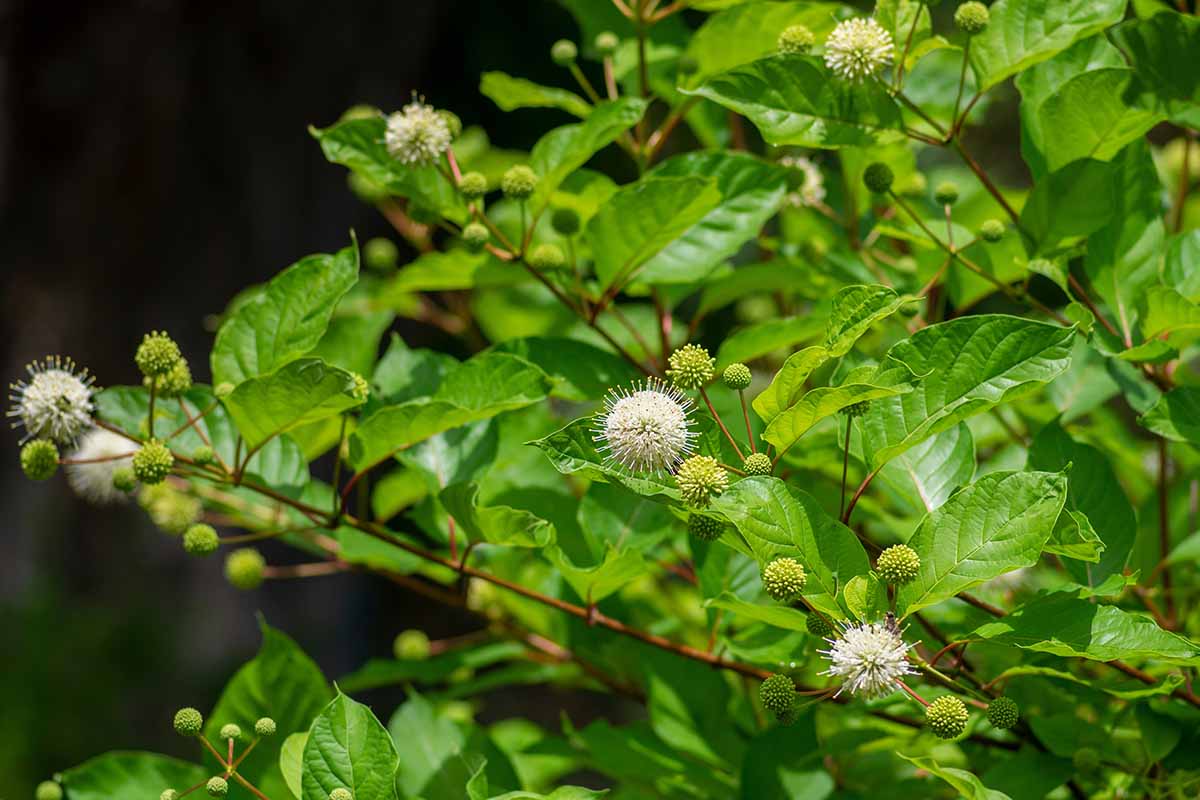
When it comes to exposure, shoot for full sun to partial shade. Full sun is best, if peak flowering is the goal.
Partial shade definitely works as well, but you might end up with less abundant blooms.
Soil Needs
C. occidentalis prefers moist and fertile soil.
Placement near water is perfect for ensuring the former, while working an inch or two of organic matter into the root zone each spring does wonders for the latter.
Water and Fertilizer Needs
Buttonbush loves water, and this plant is thirstier than a college town on Thursday night.
Provide ample moisture by ensuring the soil never dries out. If you feel dryness, make with the irrigation!

Don’t fret about overwatering – C. occidentalis can tolerate wet soils.
These shrubs can definitely handle the excess agua, whether it’s from occasional flooding or being submerged in three feet of standing water.
A slow-release, water-soluble fertilizer applied every year in spring will provide a punch of additional nutrients.
Growing Tips
- Full sun is optimal, but partial shade works too.
- Add one to two inches of organic matter to the root zone each spring.
- Don’t let the soil dry out!
Pruning and Maintenance
As with other plants, promptly pruning any damaged, diseased, or dead tissues is a smart move.

A more involved session of pruning – with the goal of shaping the shrub – can be conducted in spring, prior to the flush of new growth.
Always use sharp and sterile tools, and never remove more than a third of the plant in one go!
If your shrub is gangly and out of control, you always cut it down in early spring to revitalize it and make it more manageable.
The plant should quickly grow back to try and put its roots and shoots back in proportion.
Maintaining a few inches of mulch around the plant’s crown would be wise, to help retain moisture.
Just don’t mulch any specimens growing in standing water, as floating mulch does not make for a pretty water feature.
Buttonbush Cultivars to Select
If you’re looking for a buttonbush shrub, Nature Hills Nursery has you covered.
But if you’re looking for a buttonbush shrub with a twist, then you’d be wise to look into some cultivars.
Here are a few intriguing ones that are sure to raise an eyebrow:
Bailoptics
Sold under the trade name Fiber Optics®, ‘Bailoptics’ was discovered in seedling form in Hastings, Minnesota.
With a height and spread of five to six feet, this variety is relatively compact, and flaunts new growth that’s reddish-brown rather than green.
Smaller, differently-colored, a fun name… what more could you want?
‘Bailoptics’ is available for purchase from Nature Hills Nursery.
Bieberich
Aka Sputnik™, ‘Bieberich’ can trace its origins to Oklahoma, where it was found by Sunshine Nursery’s Steve Bieberich in a native stand.
Reaching heights and spreads of eight to 10 feet, this variety has blooms with a pale pinkness to them, and glossy green leaves with coppery bronze fall hues. How’s that for unique?
Sugar Shack
Wielding the trade name Sugar Shack®, ‘SMCOSS’ is the smallest cultivar on this list, with a mature size of three to four feet in both height and width.
A dense variety of a rather loose and open species, ‘SMCOSS’ also has red-tinged leaves and especially vibrant red fruits.
This cultivar originated from a controlled breeding program in Grand Haven, Michigan.
Dare I say, the breeders knocked this one out of the park.
For a ‘SMCOSS’ to plant at home, head over to Nature Hills Nursery.
Managing Pests and Disease
Thankfully, a buttonbush suffers hardly any serious pest and disease issues. And in most cases, proper cultivation and sanitation will turn that “hardly any” into a hard “no.”
But while villainous insects and pathogens won’t really give your C. occidentalis a hard time, deer and drought could very well strike.
Deer
Deer are notorious for eating practically everything, and a buttonbush definitely falls under that umbrella.
Unless deer-sized munching holes in foliage sound aesthetic to you, you should keep an eye out.
Deer repellents work well as a deterrent on a plant-by-plant basis, while a well-constructed deer fence will help defend the plantings throughout your property.

This granular deer repellent from Enviro Pro is a fantastic product, and it’s available from Amazon.
Drought
C. occidentalis doesn’t really suffer from root rot, a condition that can plague plants with less tolerance for water.
But with this preference for wetness comes a dislike of dryness, one that can leave a drought-affected buttonbush with yellowed, wilted, and scorched foliage.

In severe cases, drought can cause leaf drop and the plant’s eventual death.
The cure is the opposite of the cause – you gotta give the plant more water. Most of the time, this should resolve things.
But if drought has well and truly killed your plant, the best course of action is to dig it up and try again with a new specimen.
Buttonbush Best Uses
Aside from the fun “What the…?” effect that the flowers can cause in someone who’s new to buttonbushes, C. occidentalis looks pretty neat, especially after some proper pruning.
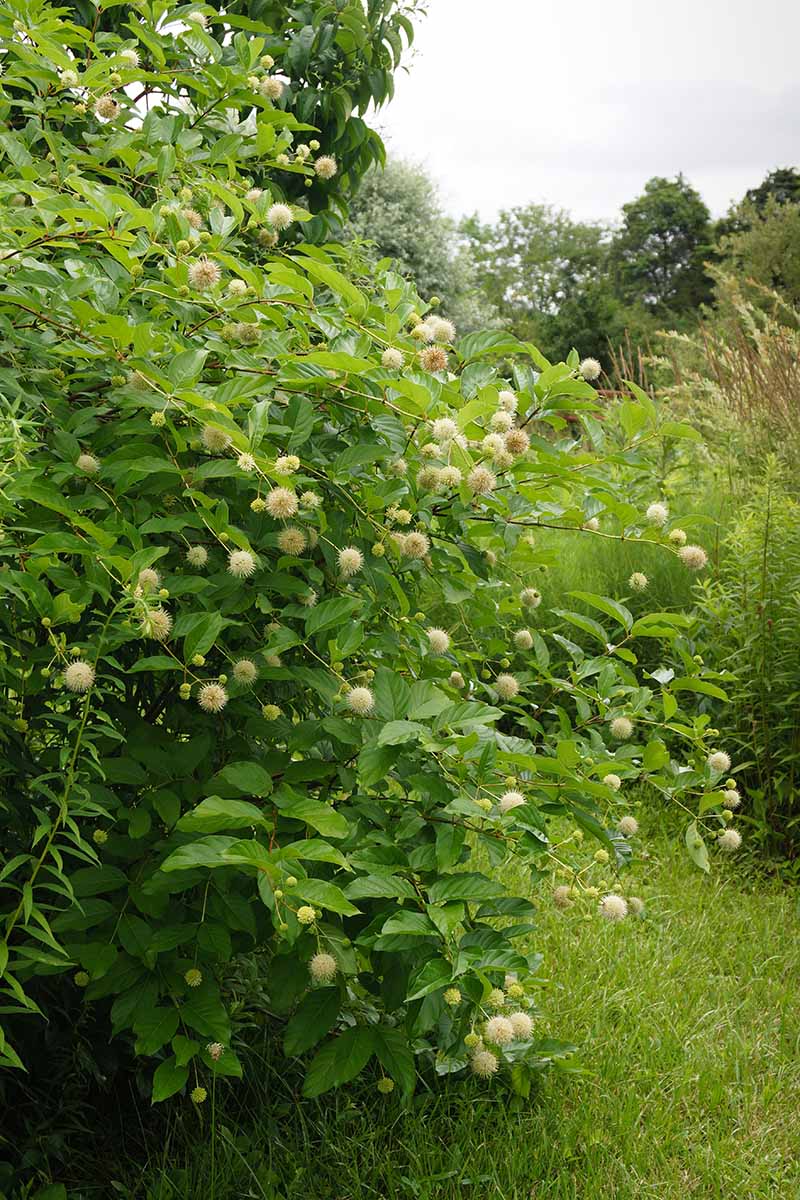
In the landscape, these shrubs look great next to water features, as shrub borders, and in native gardens.
Smaller, containerized specimens offer growers additional placement options, if desired.
The beautiful flowers and fruits are appealing to people and animals alike. Along with attracting wildlife, a buttonbush offers a fantastic means of controlling soil erosion, especially when it’s planted near water.
Quick Reference Growing Guide
| Plant Type: | Woody deciduous shrub | Flower/Foliage Color: | White/green |
| Native to: | North America | Maintenance: | Low |
| Hardiness (USDA Zones): | 4-11 | Tolerance: | Acidic soils, alkaline soils, wet soils (flooding, standing water) |
| Bloom Time: | Summer | Soil Type: | Moist to wet, fertile |
| Exposure: | Full sun, part shade | Soil pH: | 6.0-8.0 |
| Time to Maturity: | 3-4 years | Soil Drainage: | Poor to well-draining |
| Spacing: | 2 feet | Attracts: | Bees, birds, butterflies, moths, other insect pollinators |
| Planting Depth: | Just below soil surface (seeds), depth of root system (transplants) | Uses: | Attracting wildlife, containers, erosion control, native gardens, naturalizing, shrub borders, water edges, wet sites, wildlife attraction |
| Height: | 3-15 feet | Order: | Gentianales |
| Spread: | 3-15 feet | Family: | Rubiaceae |
| Water Needs: | Moderate | Genus: | Cephalanthus |
| Common Pests and Disease: | Spider mites, whiteflies; leaf spot, root rot | Species: | Occidentalis |
Cute as a Button
I mean, what other idiom punnily describes a shrub with perfectly spherical flowers and fruits?
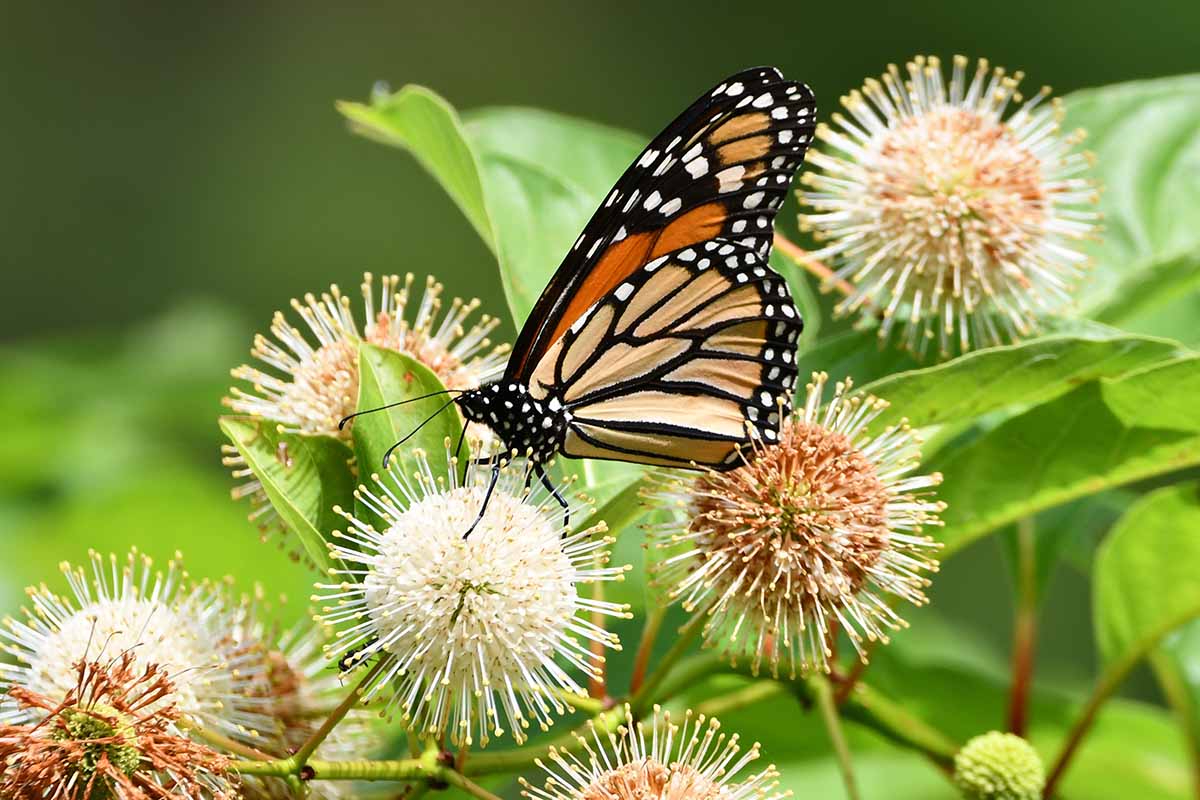
For a plant that attracts wildlife, controls erosion, and is just straight-up interesting to look at during its blooming and fruiting periods, moisture-tolerant buttonbush is the obvious choice. And now that you know how to grow one, I think your next move is also obvious.
Questions, comments, button idioms and puns that I might have missed? Put them in the comments section below.
Interested in other woody shrubs for your garden? Read these guides next:
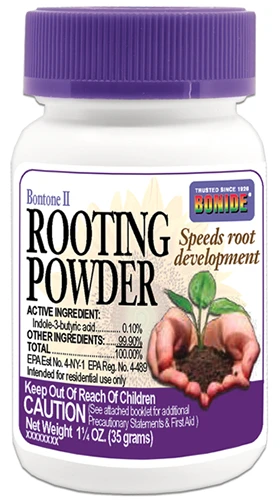
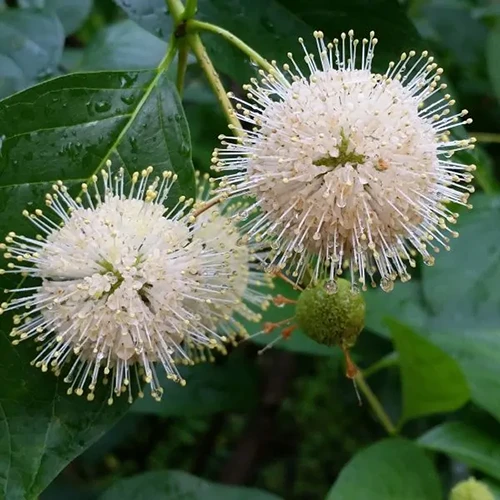
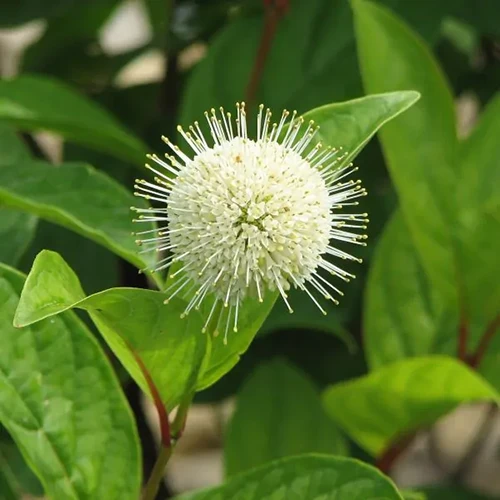
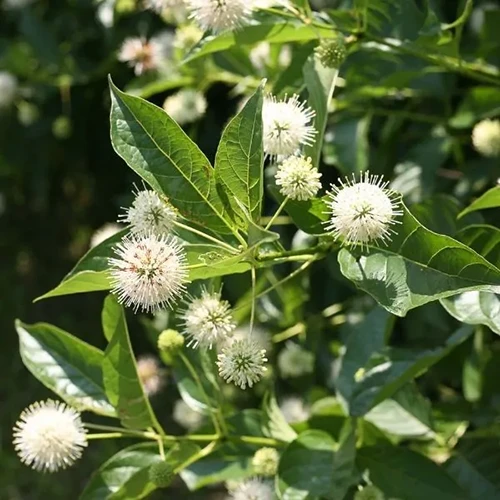

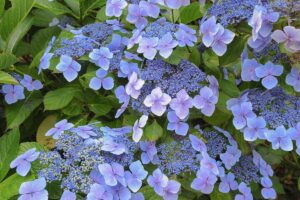

I have had Sugar Shack buttonbush for 5 years now. The plant dies back each winter (I live in Macon, GA) and starts regrowing in mid Spring. Beautiful dark green plant but has never bloomed. Planted in good soil, mulched, and watered regularly. Any ideas?
Hey, Mark! Bummer about your buttonbush… how much sun is it getting? Are you fertilizing it at all?